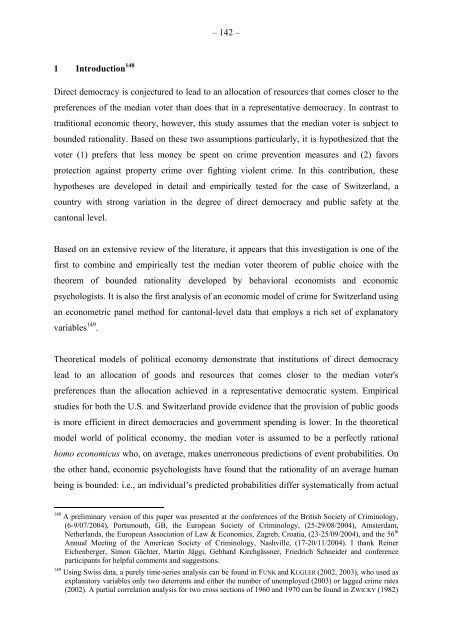The Impact of Direct Democracy on Society - Universität St.Gallen
The Impact of Direct Democracy on Society - Universität St.Gallen
The Impact of Direct Democracy on Society - Universität St.Gallen
- No tags were found...
You also want an ePaper? Increase the reach of your titles
YUMPU automatically turns print PDFs into web optimized ePapers that Google loves.
– 142 –1 Introducti<strong>on</strong> 148<str<strong>on</strong>g>Direct</str<strong>on</strong>g> democracy is c<strong>on</strong>jectured to lead to an allocati<strong>on</strong> <str<strong>on</strong>g>of</str<strong>on</strong>g> resources that comes closer to thepreferences <str<strong>on</strong>g>of</str<strong>on</strong>g> the median voter than does that in a representative democracy. In c<strong>on</strong>trast totraditi<strong>on</strong>al ec<strong>on</strong>omic theory, however, this study assumes that the median voter is subject tobounded rati<strong>on</strong>ality. Based <strong>on</strong> these two assumpti<strong>on</strong>s particularly, it is hypothesized that thevoter (1) prefers that less m<strong>on</strong>ey be spent <strong>on</strong> crime preventi<strong>on</strong> measures and (2) favorsprotecti<strong>on</strong> against property crime over fighting violent crime. In this c<strong>on</strong>tributi<strong>on</strong>, thesehypotheses are developed in detail and empirically tested for the case <str<strong>on</strong>g>of</str<strong>on</strong>g> Switzerland, acountry with str<strong>on</strong>g variati<strong>on</strong> in the degree <str<strong>on</strong>g>of</str<strong>on</strong>g> direct democracy and public safety at thecant<strong>on</strong>al level.Based <strong>on</strong> an extensive review <str<strong>on</strong>g>of</str<strong>on</strong>g> the literature, it appears that this investigati<strong>on</strong> is <strong>on</strong>e <str<strong>on</strong>g>of</str<strong>on</strong>g> thefirst to combine and empirically test the median voter theorem <str<strong>on</strong>g>of</str<strong>on</strong>g> public choice with thetheorem <str<strong>on</strong>g>of</str<strong>on</strong>g> bounded rati<strong>on</strong>ality developed by behavioral ec<strong>on</strong>omists and ec<strong>on</strong>omicpsychologists. It is also the first analysis <str<strong>on</strong>g>of</str<strong>on</strong>g> an ec<strong>on</strong>omic model <str<strong>on</strong>g>of</str<strong>on</strong>g> crime for Switzerland usingan ec<strong>on</strong>ometric panel method for cant<strong>on</strong>al-level data that employs a rich set <str<strong>on</strong>g>of</str<strong>on</strong>g> explanatoryvariables 149 .<str<strong>on</strong>g>The</str<strong>on</strong>g>oretical models <str<strong>on</strong>g>of</str<strong>on</strong>g> political ec<strong>on</strong>omy dem<strong>on</strong>strate that instituti<strong>on</strong>s <str<strong>on</strong>g>of</str<strong>on</strong>g> direct democracylead to an allocati<strong>on</strong> <str<strong>on</strong>g>of</str<strong>on</strong>g> goods and resources that comes closer to the median voter'spreferences than the allocati<strong>on</strong> achieved in a representative democratic system. Empiricalstudies for both the U.S. and Switzerland provide evidence that the provisi<strong>on</strong> <str<strong>on</strong>g>of</str<strong>on</strong>g> public goodsis more efficient in direct democracies and government spending is lower. In the theoreticalmodel world <str<strong>on</strong>g>of</str<strong>on</strong>g> political ec<strong>on</strong>omy, the median voter is assumed to be a perfectly rati<strong>on</strong>alhomo ec<strong>on</strong>omicus who, <strong>on</strong> average, makes unerr<strong>on</strong>eous predicti<strong>on</strong>s <str<strong>on</strong>g>of</str<strong>on</strong>g> event probabilities. Onthe other hand, ec<strong>on</strong>omic psychologists have found that the rati<strong>on</strong>ality <str<strong>on</strong>g>of</str<strong>on</strong>g> an average humanbeing is bounded: i.e., an individual’s predicted probabilities differ systematically from actual148 A preliminary versi<strong>on</strong> <str<strong>on</strong>g>of</str<strong>on</strong>g> this paper was presented at the c<strong>on</strong>ferences <str<strong>on</strong>g>of</str<strong>on</strong>g> the British <strong>Society</strong> <str<strong>on</strong>g>of</str<strong>on</strong>g> Criminology,(6-9/07/2004), Portsmouth, GB, the European <strong>Society</strong> <str<strong>on</strong>g>of</str<strong>on</strong>g> Criminology, (25-29/08/2004), Amsterdam,Netherlands, the European Associati<strong>on</strong> <str<strong>on</strong>g>of</str<strong>on</strong>g> Law & Ec<strong>on</strong>omics, Zagreb, Croatia, (23-25/09/2004), and the 56 thAnnual Meeting <str<strong>on</strong>g>of</str<strong>on</strong>g> the American <strong>Society</strong> <str<strong>on</strong>g>of</str<strong>on</strong>g> Criminology, Nashville, (17-20/11/2004). I thank ReinerEichenberger, Sim<strong>on</strong> Gächter, Martin Jäggi, Gebhard Kirchgässner, Friedrich Schneider and c<strong>on</strong>ferenceparticipants for helpful comments and suggesti<strong>on</strong>s.149 Using Swiss data, a purely time-series analysis can be found in FUNK and KUGLER (2002, 2003), who used asexplanatory variables <strong>on</strong>ly two deterrents and either the number <str<strong>on</strong>g>of</str<strong>on</strong>g> unemployed (2003) or lagged crime rates(2002). A partial correlati<strong>on</strong> analysis for two cross secti<strong>on</strong>s <str<strong>on</strong>g>of</str<strong>on</strong>g> 1960 and 1970 can be found in ZWICKY (1982)
















